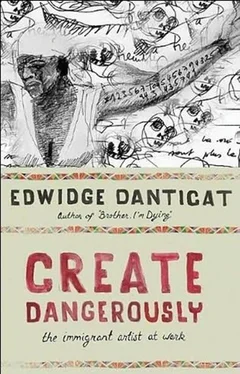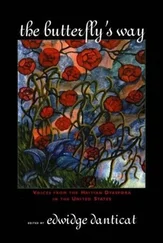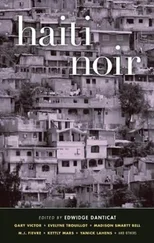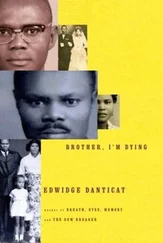Toussaint L’Ouverture reappears with a black hat and sword in Basquiat’s 1983 painting Toussaint L’Ouverture Versus Savonarola . Here Basquiat enrolls the Black Spartacus to battle the Italian priest and destroyer of so-called immortal art. Who wins that battle in Basquiat’s mind? Perhaps one day this painting may inspire some type of avant-garde video game.
Haiti, like Puerto Rico and the continent of Africa, was obviously both in Basquiat’s consciousness and in his DNA, but they were not there by themselves. Basquiat did not belong to any fixed collective. He freely borrowed from and floated among many cultural and geographic traditions. Like many other culturally mixed, first- or second-generation Americans, his collectivity was fluid. He was symbiotic and syncretic in the same way that Hector Hyppolite’s Vodou paintings were, mixing European Catholicism and African religious rites and adapting them to a world made new by the artist’s vision or, in both Hyppolite’s and Basquiat’s case, visions.
In digging deeper for a Haitian influence in Basquiat’s oeuvre, one might identify as Ogoun his arrow-wielding men or as a tribute to Baron Samedi and Erzulie his heart-covered skulls and crosses. But even if this were undeniably true, even if Basquiat were, like Hyppolite, purposely drawing vèvès and other visual tributes to the lwas , he was also trying to repel ghosts, much like the sad and frightened-looking young man in the painting of that name. A young man who seems almost split in two, wearing a cross (or is it an ankh?) around his neck, while leaning on an old man’s cane, like Legba, the gatekeeper, the lwa who mediates between the world of the spirits and the world of mortals, the god who stands at physical and spiritual intersections, the one to whom one has to say to be allowed safe passage, “Papa Legba, please make a way, open the gates for me.”
The bottom half of the young man’s body in To Repel Ghosts is claimed by an unfinished heart. Might it belong to Erzulie, the Haitian goddess of love, who often demands ritual marriage to promising men, something to which Hyppolite might have been more amiable than Basquiat? Hector Hyppolite would never think of repelling his ghosts. He welcomed them. They had chosen him, inspired him. They had nurtured his art. Maybe they’d done the same for Basquiat, but something may have been lost in the translation and Basquiat may not have been able to recognize or understand them.
Basquiat died of a drug overdose in 1988 at age twenty-seven. Perhaps if he had lived, he would have learned to embrace these types of ghosts, among his many others. We never got to see, for example, how Basquiat’s brief and much-anticipated trip to the Ivory Coast might have affected his work. He might have altered his style a bit (or not) or he might have changed directions completely, becoming the poet he’d told friends he wanted to be. Hyppolite too might have changed styles or direction had he not died of a heart attack in 1948 at age fifty-four. Who knows where the spirits might have led them both? Or maybe they had fulfilled their missions and had nothing more to do or say, or create.
In Vodou, it is believed that when one dies, one returns to Ginen, the ancestral homeland from which our forebears were taken before being brought to the New World as slaves. Ginen stands in for all of Africa, renaming with the moniker of one country an ideological continent which, if it cannot welcome the returning bodies of its lost children, is more than happy to welcome back their spirits. In Vodou, it is also believed that possession, trance, is an opportunity for the spirits to speak to mortals and the person who is in trance, or possessed, becomes the vessel, the chwal or divine horseman or horsewoman, through whom the spirits speak. Both Basquiat and Hyppolite were in a type of trance, divine horsemen, possessed, as their hyperproductivity shows, by spirits they were seeking to either welcome or repel. Possession, however, is not supposed to last a lifetime. Neither the body nor the mind could bear or sustain it.
It may be that Basquiat knew this all too well. When Marc Miller asked him about the Haitian primitives who should have been nailed to his walls, perhaps all Basquiat could think of was the primitive in the mirror, the anonymous inventor, who was plucked from obscurity and turned into a god only to be continually called crude, naive, savage, and later even “a Madison Avenue Primitive,” as he was labeled in a November 9, 1992, review by Adam Gopnik in the New Yorker . Gone, except in these perhaps misunderstood shapes and forms, maybe the Madison Avenue primitive is now side by side with the Trou de Cochon primitive, if not in some collector’s storage space, then in their common ancestral Ginen, or possibly, in a few cheap prints nailed to some young artist’s wall.
Acheiropoietos
On November 12, 1964, after Marcel Numa and Louis Drouin were executed and their bodies carried away, some say to the national palace to be personally inspected by François “Papa Doc” Duvalier, a lanky thirteen-year-old boy who had been standing in the back of the crowd to avoid the thunderous sounds of the executioner’s guns, stepped forward as the spectators and soldiers scattered. He walked toward the bullet-ridden poles, bent down in the blood-soaked dirt, and picked up the eyeglasses that Louis Drouin had been wearing.
The young man, Daniel Morel, only momentarily held the eyeglasses in his hands before they were snatched away by another boy, but in the moment he had them, he’d noticed tiny chunks of Drouin’s brain splattered on the cracked lenses. Perhaps if he had kept them, he might have cleaned the lenses and raised them to his face, to try to see the world the way it might have been reflected in a dead man’s eyes. Often in Haiti, the eyes of murder victims are gouged out by their murderers because it is believed that even after death, the last image a person sees remains imprinted on his or her cornea, as clearly as a photograph.
Before witnessing the execution of Marcel Numa and Louis Drouin, Daniel Morel was not particularly interested in dead men’s eyes. He had been like any other boy, going for long walks all over Port-au-Prince and playing soccer with his friends. He sometimes worked in his father’s bakery and tried to climb aboard Haiti’s commercial train, which brought sugarcane stalks from the southern fields of Léogâne to the sugar-making plant in Port-au-Prince. But the execution changed everything.
The next day, he walked by a photographer’s studio near his father’s bakery in downtown Port-au-Prince, and on the open paneled doors were enlarged photographs of Marcel Numa and Louis Drouin’s corpses, purposely put on display as deterrents for the country’s potential dissenters. These pictures were exhibited there and elsewhere for weeks and young Daniel Morel would walk past them, and even though he had been at the execution, he saw them each day as if for the first time, and was unable to look away.
“That’s when I decided to be a photojournalist,” Daniel recalled more than forty-five years later, while sitting at the dining room table in my home in Miami’s Little Haiti neighborhood.
We had met nearly a decade earlier while I was in Haiti with some Haitian American journalist friends. It was All Saints’ Day and we had all gone with him to Port-au-Prince’s national cemetery to watch groups of people sing, dance, and pray inside the cemetery, to honor their dead.
No one is absolutely certain now where Numa and Drouin are buried, so I know that they were not among the dead being singled out for prayers at the national cemetery that day. From the images I had seen of the execution, I had tried while walking along the narrow corridors between the mausoleums and graves to figure out the location. I had decided that a cracked and graffiti-covered cement wall next to the main entrance might be the spot, a wall with a bustling neighborhood and a trash-filled ravine on its outer side.
Читать дальше












